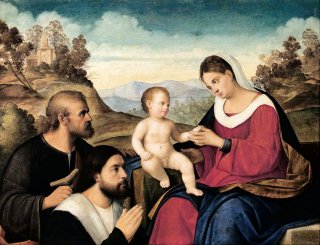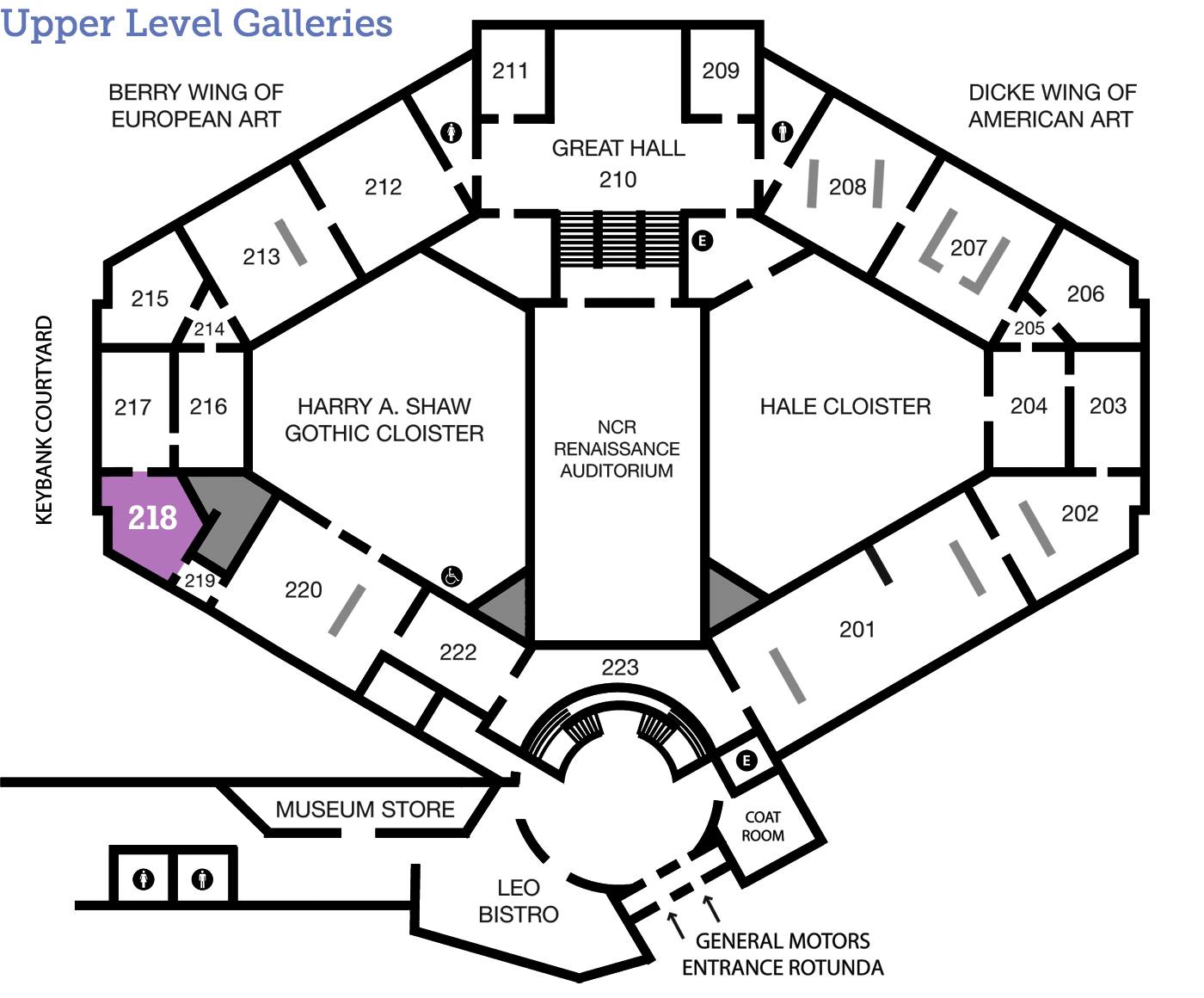
Pier Francesco Bissolo
The Holy Family with a Donor in a Landscape
(active 1492–1554)Early 1520s Oil on wood panel 31 1/2 x 39 3/4 inches Museum purchase with funds provided by the John Berry Family, The James F. Dicke Family, and the Deaccessioned Works of Art Fund 1998.41
Adorable
How do you express love for the important things in your life? Are you restrained or exuberant? Subtle or obvious? Join this quartet and discover anew the joy of devotion.
A Day in the Life
Taking Credit
500 years ago, the clothing worn by the donor would have made him stick out like a sore thumb because his clothing was modern at the time—there are 1,500 years of fashion trends between the Holy Family and the donor! In the Renaissance it was common practice for donors to make their patronage known by having themselves included in a work of art itself.
Poll
If you contributed to the creation of a work of art today, how would you want to demonstrate your patronage?
Tools and Techniques
Behind the Scenes
Missing Piece
Why was The DAI lucky to acquire this painting? How does it fill a gap in the European permanent collection? Find out more from Alex Nyerges, Director and CEO of The DAI from 1992–2006, in the following audio clip.
Transcript:
This spectacular High Renaissance painting of the Venetian school from probably the early 1520s by Pietro Franceso Bissolo, who was a student of the great Italian painter Bellini, is as fine an example of High Renaissance painting as you will find: the balance of the figures, the use of these vibrant primary colors, and the really warm, wonderful display of human emotions. You can feel the emotion, especially of the patron who sits with his hands clasped in a manner of prayer, looking at the baby Jesus and his mother, and thinking thoughts that a patron obviously should be thinking. This was, at the time it was acquired, the most expensive single work of art ever acquired by The [Dayton] Art Institute. This work came to us very providentially from a collection in England, and had been published and well known since the nineteenth century. In fact, it had been included in a number of volumes by Bernard Berenson. Berenson was the noted scholar of Italian Renaissance painting on which we rest many of our ideas of the Italian Renaissance. But we were quite lucky to be able to acquire it because this kind of work, being in private hands for this long, is highly unusual and it was fortunate because it filled a major gap in the collection of The Dayton Art Institute with respect to our European painting collection.
Look Closer
Just for Kids
Imagine!
The baby Jesus is seated with his mother, Mary. Joseph stands next to Jesus. But who is the man at the bottom? He is a donor. When someone is included in a painting with Christian figures during the Renaissance (14th to 17th century), it showed other people that they and their family were religious and wealthy.
Imagine if thought bubbles were coming from this painting. What do you think each of the figures are thinking about in this moment?
Signs & Symbols
Dig Deeper
Three's Company
Who is the extra man joining the Holy Family of Mary, Joseph, and the baby Jesus? Listen as Roger Crum, Professor of Art History at the University of Dayton, explores one way it was common for wealthy individuals to show religious devotion in Italy during the 1500s.
Transcript:
Hello, my name is Roger Crum, and I teach the history of Italian Renaissance art at the University of Dayton. Here at The Dayton Art Institute, one of the works of art that is of particular interest to me is this Holy Family with Donor from the High Renaissance period. I’m interested in this piece because given that we live in an era in which the collectors of works of art are often as famous as the artists whose works they collect, this work of art stands as a kind of antecedent to that equal fame that comes about between collectors and artists.
We have here a work of art with a very traditional religious subject, namely the Holy Family, in which we see the Virgin Mary, the Christ Child, and the figure of Joseph. But one of the notable things about this painting is the presence of the gentleman in the lower left hand corner, inserted quite prominently in the assemblage there between Joseph on the left and the Christ Child and the Virgin Mary on the right. His presence is therefore far from insignificant. He’s been literally entered into the composition; the question is, “Why?”
The Renaissance was a period in which you see a growing individualism, a growing worldliness, but yet there was still a very powerful draw that the church had. Individuals wanted to be associated with religion, and individuals were deeply concerned about the fate of their existence, the fate of their souls in the afterlife. So it was very common for individuals of means to commission works of art in which they would request of the painter to include a representation of them, as we see with this anonymous gentleman here in Bissolo’s painting. He’s there clearly not strictly as a matter of portrayal, but he’s there in an act of supplication—that is to say an act of prayer—in which he is actively present in the midst of the Holy Family, while he is simultaneously clearly showing a sign of devotion as we see his clasped hands in a sign of prayer. Hence, we have to understand, or simply assume, that this individual is not merely promoting his own person here, but he is making some investment in his salvation, and perhaps the salvation of his family, by including himself in this work.
Arts Intersected
Hearing the Renaissance
If you saw this painting when it was made in Italy, what music might you have heard in a church nearby? Find out by listening to the Dayton-based Wind in the Woods Early Music Ensemble perform the song “Quem Vidistis Pastores” (“Who have you seen, shepherds?”) by the composer Orlando di Lasso (c. 1530–1594), who worked in Italy at about the same time as Bissolo.
Performed by Jenelle Allen, Dan Duncan, Margaret Erin, Michael Mattimore, Lawrence Pitzer, Amy Vaubel.
For more information on performances and recordings by Wind in the Woods Early Music Ensemble, please visit http://www.windinthewoodsearlymusic.com.
The Sculpture Speaks
Did You Know?
Expert Opinion
Human and Divine
Why is this painting a wonderful example of Northern Italian art of the High Renaissance in the early 1500s? Find out from Dominique Vasseur, former Senior Curator at The DAI from 1979-1999, in the following audio clip.
Transcript:
Hello, this is Dominique Vasseur. I was curator at The Dayton Art Institute from 1979—1999. While The Dayton Art Institute has a wonderful collection of Old Master paintings, one thing that it lacked for much of its history was a truly great and beautifully scaled High Renaissance painting—just such as this one, by Pier Francesco Bissolo, a Venetian artist. It wasn’t until 1998 that the museum was able to acquire this work, with funds provided by the Berry and Dicke families. It really is a marvelous painting that speaks to the High Renaissance, and the great contribution of the Renaissance was the vitality that it infuses into art. The very fact that the Holy Family—the Christ Child and his mother and Saint Joseph—are seated in what appears to be a Venetian landscape, or that is to say a Northern Italian landscape, and that they are accompanied right in their picture by a donor who—although we don’t know who he is we presume that he may have funded or commissioned this painting—this kind of human interaction of real, live people, the mingling of mortal human beings and the divinity really is what the Renaissance is about. It’s about the vitality that is both in life and that is instilled into religious art.
Look Around
About the Artist
Talk Back
Moving Pictures
The subtle expression on the face of each figure gives this painting a quiet vitality and even a sense of mystery. What are some of the different ways an artist can create emotion in a work of art? If a color was changed in this painting, or the figures were moved around, how might that affect the emotions you feel?

